Join the best fashion designing college in Jaipur for a successful career and experiencing new opportunities in the field of fashion technology. Fashion Designing develops an understanding of clothing and lifestyle. The discipline enables students to develop their existing artistic skills which is a key necessity for attaining success in the fashion industry. Poddar College offers diploma and degree programs in fashion designing. In addition to this, prominent personalities from the fashion industry regularly visit to help students understand the industry, its challenges, and opportunities in a better way.
Don't wanna be here? Send us removal request.
Text
Quantum Computing: Navigating the Quantum Landscape of Infinite Possibilities
Quantum computing, a revolutionary frontier in the field of information processing, has captured the imagination of scientists, engineers, and futurists alike. Beyond the confines of classical computing, quantum computing leverages the principles of quantum mechanics to usher in a new era of computation with unprecedented power and capabilities. This article by Poddar International School, the best BCA college in Jaipur, undertakes an extensive exploration of the foundations, applications, challenges, and transformative potential of quantum computing.

Foundations of Quantum Computing
At the heart of quantum computing lies the quantum bit, or qubit. Unlike classical bits, which exist in states of 0 or 1, qubits harness the peculiar principles of superposition and entanglement. Superposition allows qubits to exist in multiple states simultaneously, opening the door to parallel computations and exponentially increasing computational capacity.
Entanglement, a quantum phenomenon, is another cornerstone of quantum computing. When qubits become entangled, the state of one qubit instantaneously influences the state of its entangled partner, irrespective of the distance between them. This unique interconnectedness imparts a level of coherence that sets quantum systems apart from classical ones.
Quantum Supremacy
In 2019, Google's quantum processor, Sycamore, outpaced the most powerful classical supercomputers in performing a specific task. This demonstrated that quantum computers could handle problems that were once deemed insurmountable due to the limitations of classical computing.
However, it's crucial to understand for students of the MCA course in Jaipur and India that achieving quantum supremacy in a controlled environment does not imply the immediate obsolescence of classical computers. Classical computers excel in many practical applications and will continue to coexist with quantum computers, each playing a distinctive role in solving different classes of problems.
Quantum Entanglement and Superposition
Superposition and entanglement are key to quantum advantage. Superposition allows qubits to exist in multiple states simultaneously, enabling quantum computers to explore many possibilities at once. This results in significant computational speedup for tasks like factoring large numbers, optimizing routes, and simulating quantum systems.
Entanglement, on the other hand, provides a form of correlation between qubits that classical systems lack. The entanglement of qubits enhances the coherence of quantum systems, contributing to their computational power. Researchers are actively exploring ways to utilize and control entanglement for practical applications, such as quantum communication and distributed quantum computing.
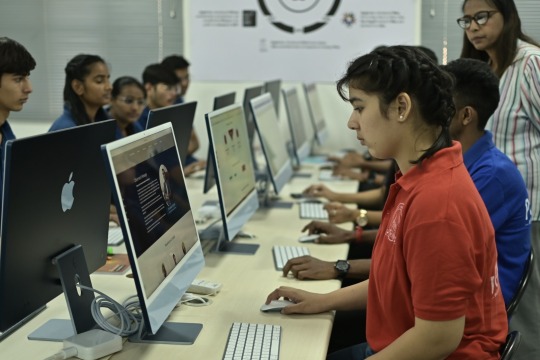
Applications of Quantum Computing
Let us now discuss some of the prominent applications of quantum computing:
1. Cryptography: Quantum computers pose both a threat and an opportunity for cryptography. They have the potential to break widely used encryption algorithms, sparking the need for quantum-resistant cryptographic techniques. Simultaneously, quantum communication offers secure methods for transmitting information through quantum key distribution.
2. Optimization Problems: Quantum computers excel at solving complex optimization problems, a domain where classical computers often struggle. From route optimization and financial modeling to supply chain management, the ability to explore multiple possibilities simultaneously makes quantum computers invaluable for addressing real-world optimization challenges.
3. Drug Discovery: Quantum computers offer a revolutionary approach to simulating molecular and chemical interactions. The precise modeling capabilities of quantum computers accelerate drug discovery processes, leading to the development of new pharmaceuticals and materials with unprecedented efficiency.
4. Machine Learning: Quantum computing promises to revolutionize machine learning by accelerating complex calculations involved in training and running machine learning models. Quantum machine learning models have the potential to outperform classical models in certain applications, paving the way for advancements in artificial intelligence.
5. Quantum Simulation: Quantum computers excel at simulating quantum systems, providing insights into the behavior of particles at the quantum level. Our BCA course in Jaipur discusses how this is crucial for advancing our understanding of quantum physics, materials science, and other fields where quantum effects play a significant role.
6. Financial Modeling: Quantum computing's ability to handle complex optimization problems makes it well-suited for financial modeling. Quantum algorithms can be employed to optimize portfolios, simulate market dynamics, and address intricate financial calculations with unparalleled speed.
Challenges and Solutions
As promising as quantum computing is, it faces significant challenges that must be overcome to unleash its full potential.
1. Quantum Decoherence: Quantum systems are susceptible to decoherence, where the delicate quantum states of qubits degrade over time due to environmental factors. Researchers are exploring error correction techniques, such as quantum error correction codes, to mitigate the effects of decoherence and enhance the reliability of quantum computations.
2. Scalability: Building larger and more powerful quantum systems requires addressing issues related to scalability. Qubit connectivity, stability, and minimizing interference from the external environment are crucial factors in scaling quantum architectures. Top BCA colleges in Jaipur and India actively discuss how different approaches, including superconducting qubits, trapped ions, and topological qubits, are being explored to tackle scalability challenges.
3. Quantum Gate Fidelity: Achieving high fidelity in quantum gates is essential for performing accurate quantum computations. Improving the accuracy of quantum gates involves developing better hardware, error correction techniques, and optimizing the control mechanisms for qubits.
4. Quantum Software Development: Developing algorithms and software for quantum computers poses unique challenges. Quantum algorithms require a different mindset and approach compared to classical algorithms. Researchers and developers are actively working on creating a quantum software ecosystem to facilitate the design and implementation of quantum algorithms.
5. Quantum Hardware Challenges: Building reliable and scalable quantum hardware is a formidable task. From creating stable qubits to minimizing interference and maintaining coherence, researchers are continually innovating to improve the performance and reliability of quantum processors.

Quantum Computing Technologies
Several quantum computing technologies are being explored to overcome existing challenges and advance the field. Students at Apple Lab in Jaipur learn about the latest developments in quantum computing technology. Here are some of the new technologies you can explore:
1. Superconducting Qubits: Superconducting qubits, which operate in a superconducting state, are a leading candidate for building quantum processors. These qubits can be manipulated using microwave pulses and offer a scalable approach to quantum computing.
2. Trapped Ions: Trapped ions, typically individual atoms held in electromagnetic fields, are another promising technology. Qubits in trapped ion systems can be manipulated with high precision using laser beams, offering excellent qubit coherence.
3. Topological Qubits: Topological qubits are based on anyons, exotic particles that exist in certain materials. These qubits are inherently more robust against errors and decoherence, making them an attractive candidate for building fault-tolerant quantum computers.
4. Quantum Dots: Quantum dots, semiconductor-based artificial atoms, are being explored for qubit implementation. These tiny structures offer the potential for integrating quantum computing capabilities into existing semiconductor technologies.
Conclusion
Quantum computing stands at the cusp of a transformative revolution in information processing. The shift from theoretical concepts to practical quantum processors has immense potential, impacting fields such as cryptography, optimization, drug discovery, and machine learning. However, the path to realizing the full potential of quantum computing requires overcoming issues such as quantum decoherence, scalability, and quantum gate fidelity. This requires collaborative efforts from researchers, engineers, and industry stakeholders. The development of robust quantum hardware and the creation of a sophisticated quantum software ecosystem are critical components of this journey.
Prominent IT colleges in Jaipur and India advocate for a multidisciplinary approach that combines quantum physics, materials science, computer science, and information theory. The ethical implications of quantum computing must also be carefully considered to ensure that the benefits of this revolutionary technology are harnessed responsibly. As we navigate the quantum landscape, the integration of classical and quantum computing will shape the future of information processing, unlocking new realms of innovation and knowledge.
0 notes
Text
Genomics and Information Technology: Decoding the Future of Healthcare
In the vast realm of Information Technology (IT), a groundbreaking trend is taking center stage, transforming the landscape of healthcare and research—Genomics. It is the study of an organism's complete set of DNA and has witnessed a revolution fueled by advancements in IT. This article by Poddar International College, the best BCA college in Jaipur, explores the pivotal role of Genomics as an IT trend, delving into the technologies, applications, and the profound impact it has on personalized medicine and scientific discovery.

The Genomic Revolution
Genomics, as a field, has been revolutionized by high-throughput DNA sequencing technologies. The ability to rapidly and cost-effectively sequence entire genomes has ushered in an era of unprecedented insights into the genetic makeup of individuals, populations, and various species.
1. DNA Sequencing Technologies: Next-generation sequencing (NGS) technologies, such as Illumina and Pacific Biosciences, have played a pivotal role in driving the genomic revolution. These technologies allow researchers to sequence DNA with remarkable speed and accuracy, unlocking a wealth of genetic information.
2. Bioinformatics: Genomics relies heavily on bioinformatics, a field that combines biology and IT to analyze and interpret complex biological data. Bioinformatics tools and algorithms are essential for managing, processing, and extracting meaningful insights from vast genomic datasets.
Applications of Genomics in Healthcare
With our BCA and MCA courses in Jaipur, you will learn various applications of genomics across industries. Here are applications of genomics in healthcare for your reference:
1. Personalized Medicine: Genomic information enables the tailoring of medical treatments to an individual’s unique genetic makeup. This has transformative implications for disease prevention, diagnosis, and treatment, ushering in an era of personalized medicine.
2. Cancer Genomics: Genomic analysis of cancer tumors provides critical insights into the genetic mutations driving the disease. This information guides the development of targeted therapies, improving treatment outcomes and reducing side effects.
3. Rare Disease Diagnosis: Genomics aids in the identification of genetic variants associated with rare diseases. This is instrumental in diagnosing conditions that might be challenging to identify through traditional methods.
4. Pharmacogenomics: Understanding the genetic variations that influence an individual’s response to drugs is crucial for optimizing medication regimens. Pharmacogenomics helps prescribe medications that are more likely to be effective and well-tolerated.
5. Population Genomics: Studying the genetic diversity within populations provides insights into disease susceptibility, ancestry, and evolutionary processes. It contributes to our understanding of genetic factors underlying common and complex diseases.
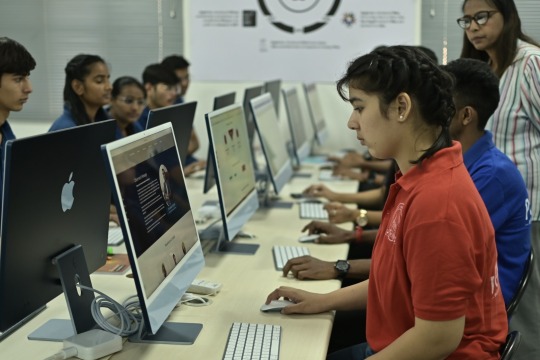
Benefits and Challenges
Our IT college in Jaipur evaluates both the advantages and potential issues of any topic discussed to help students understand comprehensively. Here are some of the benefits and challenges of genomics and information technology in the healthcare industry:
1. Medical Breakthroughs: Genomics has facilitated groundbreaking discoveries, leading to the development of targeted therapies and precision medicine approaches. This has the potential to revolutionize how we treat and manage diseases.
2. Ethical and Privacy Concerns: The vast amount of sensitive genetic information raises ethical and privacy concerns. During our BCA course in Jaipur, we emphasize that safeguarding genomic data is crucial to maintaining public trust and ensuring responsible use of genetic information. This helps students understand the importance of ethical concerns in this domain.
3. Data Management and Analysis: The sheer volume of genomic data generated requires advanced IT infrastructure for storage, management, and analysis. Handling big data challenges in genomics is an ongoing focus for IT researchers and professionals.
4. Interdisciplinary Collaboration: Genomics necessitates collaboration between biologists, clinicians, and IT experts. Bridging the gap between these disciplines is vital for translating genomic data into actionable insights and improving patient outcomes.
The Future of Genomics and IT
As IT continues to advance, the synergy between genomics and information technology is expected to deepen. Key trends shaping the future include:
1. AI and Machine Learning: Integrating artificial intelligence (AI) and machine learning (ML) into genomics accelerates data analysis, enhances predictive modelling, and identifies complex patterns within genomic datasets.
2. Blockchain Technology: Blockchain offers a secure and transparent framework for managing genomic data, addressing concerns related to privacy and data integrity. It ensures that individuals maintain control over their genetic information.
3. Cloud Computing: Leveraging cloud computing for genomic data storage and analysis enhances scalability and accessibility. Cloud-based solutions enable researchers and healthcare professionals to collaborate globally and process large datasets more efficiently.
ConclusionStudents at Poddar Group of Institutions, ranked among the top 5 MCA colleges in Jaipur, learned that genomics, empowered by IT, stands at the forefront of scientific and medical innovation. The amalgamation of high-throughput sequencing technologies, bioinformatics, and advanced IT infrastructure has unlocked the potential for personalized medicine, disease prevention, and a deeper understanding of human biology. As genomics continues to evolve, the collaboration between the fields of genomics and IT promises a future where genetic insights shape the healthcare sector and contribute to transformative breakthroughs in the understanding and treatment of diseases. The journey of genomics as an IT trend is a testament to the transformative power of technology in shaping the future of healthcare and scientific discovery.
0 notes
Text
Importance of Plants in Our Life: A Comprehensive Analysis
Plants play a crucial and multifaceted role in sustaining life on Earth. Their contributions to human life are immense, encompassing ecological, economic, nutritional, medicinal, and aesthetic aspects. Plants are living organisms that play an important role in our lives. They belong to the Plantae kingdom, as per science. The study of plants and their characteristics is known as Botany.
Poddar International College, a leading science college in Jaipur, ensures that students learn beyond the classroom while understanding the importance of nature in various aspects. Plants and trees are essential in our lives. Directly or indirectly, plants are connected with our lives, and we are dependent on each other. Plants provide us with various fruits, vegetables, oxygen, etc. We help them with carbon dioxide, and they help maintain the ecosystem. Growing a plant is not so easy. A sapling requires immense care to grow into a huge tree or a fully grown plant. Some of the key contributions of plants to our lives are discussed here:

1. Oxygen Production
Plants, through photosynthesis, release oxygen into the atmosphere, which is essential for the respiratory systems of animals, including humans.
2. Food Source
Plants provide the majority of the world's food supply. Fruits, vegetables, grains, legumes, and nuts are all derived from plants and form the basis of a balanced and nutritious diet.
3. Medicinal Resources
Many pharmaceuticals and traditional medicines are derived from plants. You will learn through an M.Sc course in Jaipur that plants produce compounds with therapeutic properties that are used to treat various illnesses and conditions.
4. Climate Regulation
Plants contribute to climate regulation by absorbing carbon dioxide during photosynthesis, helping to mitigate the impacts of climate change. Forests, in particular, act as carbon sinks.
5. Ecosystem Services
At Poddar International College, considered the best M.Sc college in Jaipur, students learn how plants provide crucial ecosystem services, such as water purification, soil stabilization, and support for biodiversity. They play a key role in maintaining the balance and health of ecosystems.
6. Raw Materials
Plants are a source of raw materials for various industries. Wood, fibres, oils, and resins derived from plants are used in construction, textiles, cosmetics, and other manufacturing processes.
7. Aesthetic and Recreational Value
Plants contribute to the beauty of our surroundings and enhance the quality of life. Gardens, parks, and natural landscapes offer aesthetic enjoyment and serve as spaces for recreation and relaxation.
8. Air Quality Improvement
Plants help improve air quality by absorbing pollutants and releasing oxygen. They play a role in reducing the impact of air pollution in urban and industrial areas. Top B.Sc colleges in Jaipur include different types of pollutants, their impact on the environment, and how plants help mitigate their impact in their curriculum for a better understanding of students.
9. Biodiversity Support
Plants form the foundation of terrestrial ecosystems, supporting a vast array of animal life. They provide habitats, food, and resources for countless species, contributing to biodiversity.
10. Economic Impact
Agriculture, forestry, and horticulture are major economic sectors that rely on plants. Plants are a source of income, employment, and trade, contributing significantly to global economies.
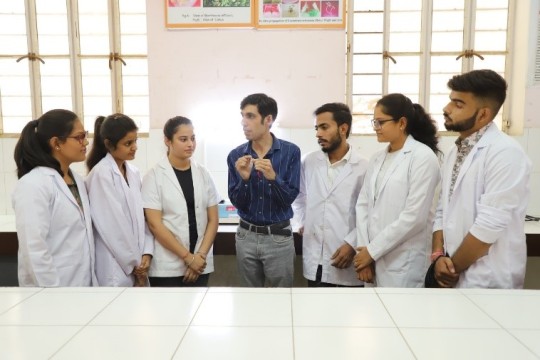
11. Educational and Scientific Value
Plants are essential for scientific research and education. They serve as model organisms for studying various biological processes and ecosystems, contributing to our understanding of life on Earth.
12. Cultural Significance
Plants hold cultural and symbolic importance in various societies. They are integral to religious ceremonies, traditions, and folklore, shaping cultural identities and practices.
ConclusionWith our B.Sc course in Jaipur, students learn that plants are not only vital for the survival of ecosystems and the planet but also integral to the well-being, sustenance, and cultural richness of human societies. Appreciating and understanding the contributions of plants is crucial for promoting environmental stewardship and sustainable practices.
0 notes
Text
Understanding the Power of Algebra: Key to Mathematical Mastery
Algebra, often regarded as the cornerstone of advanced mathematics, serves as a powerful tool for solving complex problems, modeling real-world scenarios, and unlocking the mysteries of the mathematical universe. Originating from the Arabic word "al-jabr," meaning "reunion of broken parts," algebra has evolved over centuries to become an indispensable branch of mathematics with applications in various fields. At Poddar International College, the top-ranked B.Sc college in Jaipur, students learn about Algebra comprehensively as part of their curriculum. This article will discuss foundations, objectives, types, concepts, and applications of Algebra.
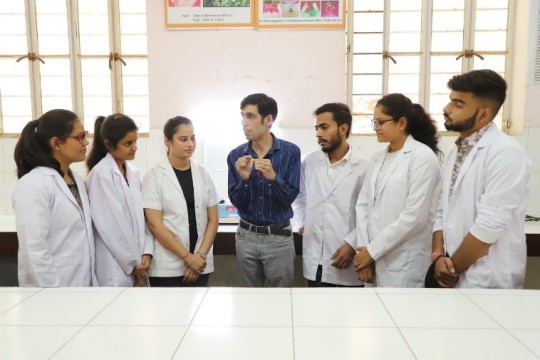
Foundations of Algebra
At its core, algebra deals with mathematical symbols and the rules for manipulating these symbols. The fundamental building blocks include variables, constants, and operations such as addition, subtraction, multiplication, and division. Equations, expressions, and inequalities become the language through which algebra communicates mathematical relationships.
Solving Equations
One of the primary objectives of algebra is to solve equations, where an equation is a statement that asserts the equality of two expressions. With a B.Sc or M.Sc course in Jaipur, you will learn that through the systematic application of algebraic operations, variables can be isolated and solutions to equations can be determined. This ability to find unknown values lies at the heart of algebra's problem-solving prowess.
Linear Algebra
Linear algebra, a prominent branch of algebra, focuses on the study of linear equations and their representations through matrices and vectors. It plays a vital role in diverse fields such as physics, computer science, economics, and engineering. Linear algebra enables the understanding and manipulation of systems with multiple variables and equations, paving the way for sophisticated problem-solving techniques.
Polynomials and Factorization
Top M.Sc colleges in Jaipur teach two important concepts of algebra: polynomials and factorization. Polynomials are expressions consisting of variables and coefficients. Factorization, a key skill in algebra, involves breaking down complex polynomials into simpler components. This process not only aids in simplifying expressions but also holds significant importance in solving equations and understanding the roots of mathematical functions.
Algebraic Structures
Beyond elementary algebra, the discipline explores abstract structures such as groups, rings, and fields. These algebraic structures provide a framework for understanding symmetry, transformations, and the properties of mathematical operations. Abstract algebra plays a crucial role in advanced mathematical research and applications in areas like cryptography and coding theory.
Applications in Real Life
At Poddar International College, the best science college in Jaipur, students are taught how algebra transcends the confines of the classroom, finding practical applications in everyday life. From budgeting and financial planning to engineering and scientific research, algebraic principles underpin a myriad of real-world scenarios. Understanding algebra equips individuals with the analytical and problem-solving skills necessary for navigating the challenges of the modern world.
Conclusion
Algebra stands as a formidable intellectual tool that empowers individuals to navigate the intricacies of mathematics and apply its principles to a vast array of fields. Whether unraveling the mysteries of the universe through abstract algebra or solving practical problems in daily life, the language of algebra serves as a bridge between theoretical concepts and real-world applications. Embracing the power of algebra opens doors to a deeper understanding of mathematics and its pervasive influence on our lives.Consider applying for a B.Sc course in Jaipur with a specialization in Mathematics from Poddar International College, if you are interested in mathematics or aspire to pursue a career where mathematics is essential.
0 notes
Text
Revolutionizing Workflows: The Rise of Robotic Process Automation in IT
In the ever-evolving landscape of Information Technology (IT), one trend is radically transforming how businesses operate and manage their processes – Robotic Process Automation (RPA). This article from Poddar International School, the top IT college in Jaipur, explores the burgeoning significance of RPA as an IT trend, unravelling its fundamental principles, applications across industries, benefits, and the future implications.

Understanding Robotic Process Automation
Robotic Process Automation is a technology that employs software robots or "bots" to mimic human actions and automate rule-based, repetitive tasks across digital systems. Unlike traditional automation, RPA does not require complex integrations or modifications to existing IT infrastructure. Instead, it operates as a virtual workforce, interacting with user interfaces, processing data, and executing tasks with unparalleled speed and accuracy.
Key Components of RPA
With our BCA course in Jaipur, students learn about various technologies related to Robotics, including RPA. Here are some fundamental components of robotic process automation that one should know about:
1. Bot Development Tools: RPA platforms provide intuitive development tools that enable the creation, testing, and deployment of automation scripts. These tools often employ a visual interface, allowing developers to design automated workflows without extensive coding knowledge.
2. Bot Orchestrators: Bot orchestrators act as central command centres, managing the deployment, scheduling, and monitoring of multiple bots. They ensure seamless coordination and collaboration within the RPA ecosystem.
3. Integration Interfaces: RPA seamlessly integrates with existing applications and systems, allowing bots to interact with various software, databases, and web services. This integration capability is crucial for the automation of end-to-end processes.

Applications Across Industries
Let us now discuss some of the applications of robotic process automation across different industries:
1. Finance and Accounting: RPA is widely adopted in financial processes, automating tasks such as invoice processing, reconciliation, and data entry. This improves accuracy, reduces errors, and enhances compliance with regulatory standards.
2. Human Resources: In HR departments, RPA streamlines onboarding processes, payroll management, and employee data updates. Bots can handle repetitive administrative tasks, allowing HR professionals to focus on strategic initiatives.
3. Customer Service: Our BCA course in Jaipur will help you understand how RPA is leveraged in customer service for tasks like data extraction, ticket routing, and order processing. This ensures quicker response times and improved customer satisfaction.
4. Supply Chain Management: RPA optimizes supply chain operations by automating order processing, inventory management, and logistics coordination. This leads to enhanced efficiency and reduced operational costs.
5. Healthcare: RPA finds applications in healthcare for tasks such as claims processing, appointment scheduling, and data entry. Automation in healthcare improves accuracy and frees up valuable time for medical professionals.
Benefits of Robotic Process Automation
Here are the advantages of robotic process automation that one must consider:
1. Enhanced Efficiency: RPA accelerates task execution, reducing processing times and enhancing overall operational efficiency. Bots work tirelessly 24/7, leading to significant time and cost savings.
2. Accuracy and Compliance: Bots perform tasks with a high degree of accuracy, minimizing errors associated with manual processes. You will learn during an MCA course in Jaipur that this is particularly crucial in industries with stringent regulatory requirements, ensuring compliance and reducing the risk of costly mistakes.
3. Scalability: RPA allows organizations to scale their automation efforts easily. As business needs evolve, additional bots can be deployed to handle increased workloads without the need for extensive reconfiguration.
4. Employee Empowerment: By automating repetitive tasks, RPA empowers employees to focus on more strategic, value-added activities. This not only boosts job satisfaction but also unleashes the creative potential of human resources.
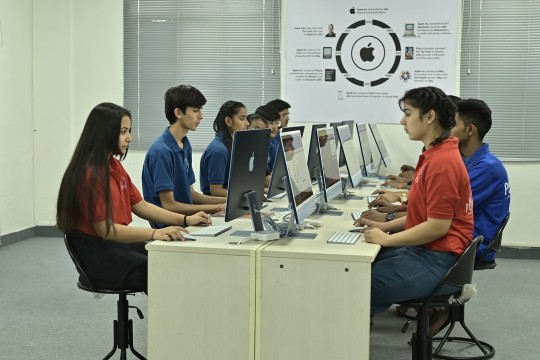
Challenges and Future Outlook
While RPA offers substantial benefits, organizations must navigate certain challenges, including:
1. Complexity of Processes: Students at our Apple Lab in Jaipur learn how RPA is most effective in automating rule-based, repetitive tasks. Processes that involve complex decision-making or require a high level of human judgment may be less suitable for automation.
2. Integration Issues: Seamless integration with existing systems is crucial for successful RPA implementation. Organizations may face challenges when dealing with legacy systems or diverse IT environments.
3. Security Concerns: As RPA involves the handling of sensitive data, security is a paramount concern. Ensuring the robustness of security protocols is essential to safeguard against potential breaches.
Looking ahead, the future of RPA is promising. Advancements in artificial intelligence (AI) and machine learning (ML) are poised to enhance the capabilities of RPA, enabling more sophisticated decision-making and adaptability. The integration of intelligent automation solutions will further amplify the impact of RPA, making it a central component in the ongoing digital transformation journey for businesses worldwide.
Conclusion
Robotic Process Automation is a transformative force in the IT landscape, offering organizations a powerful tool to enhance efficiency, reduce operational costs, and empower their workforce. As businesses increasingly recognize the potential of RPA, its integration into various industries will continue to evolve, shaping a future where automation is a cornerstone of streamlined and agile operations. RPA is not just a trend; it's a pivotal advancement that marks a significant step forward in the ongoing narrative of digital transformation within the realm of Information Technology.Are you interested in pursuing a career in IT? Explore Poddar International College, a top-ranked MCA college in Jaipur, and find insightful undergraduate and graduate courses in computer applications. Enroll today to take the first step towards a successful tech career.
0 notes
Text
Exploring the Future of Distributed Ledger Technology in Supply Chain Management
In recent years, Distributed Ledger Technology (DLT) has emerged as a transformative force in various industries, particularly in supply chain management. At Poddar International College, the top-ranked MCA college in Jaipur, we recognize the potential of DLT to enhance transparency, efficiency, and security in supply chains. This article delves into the future of DLT in supply chain management and how our college is preparing students to harness this innovative technology.

Understanding Distributed Ledger Technology
Distributed Ledger Technology refers to a decentralized database that is shared across multiple locations or among several participants. Unlike traditional databases, DLT allows for secure and transparent record-keeping without the need for a central authority. Blockchain, a type of DLT, is the most well-known example, but other forms of DLT are also gaining traction in various applications.
The Role of DLT in Supply Chain Management
Once you’ve understood DLT, you need to understand its role in supply chain management as well. Here is a breakdown of how distributed ledger technology is significant in the management of the supply chain:
1. Enhanced Transparency: One of the most significant advantages of DLT in supply chain management is its ability to provide real-time visibility into the movement of goods. Students learn with our BCA course in Jaipur that each transaction is recorded on a secure ledger, allowing all stakeholders to access the same information. This transparency helps in tracking products from origin to destination, reducing fraud and ensuring compliance with regulations.
2. Improved Traceability: DLT enables better traceability of products throughout the supply chain. At Poddar International College, the best BCA college in Jaipur, we emphasize the importance of traceability in our supply chain management curriculum, preparing students to implement DLT solutions effectively. In industries such as food and pharmaceuticals, where safety and quality are paramount, the ability to trace a product's journey can prevent contamination and ensure accountability.
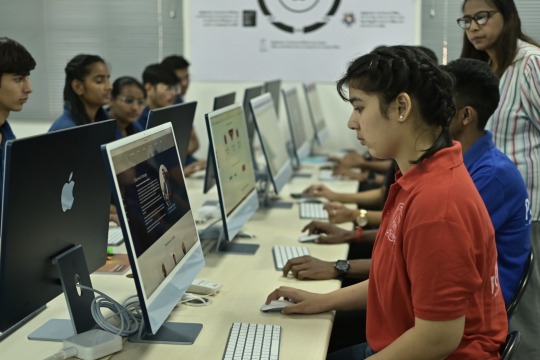
3. Streamlined Processes: By automating processes through smart contracts—self-executing contracts with the terms of the agreement directly written into code—DLT can significantly reduce the time and costs associated with supply chain transactions. This automation minimizes human error and enhances operational efficiency, allowing businesses to respond quickly to market changes.
4. Enhanced Security: DLT provides a high level of security due to its decentralized nature. Each transaction is encrypted and linked to the previous one, making it nearly impossible to alter or tamper with the data. This security is crucial for protecting sensitive information and maintaining trust among supply chain partners.
The Future of DLT in Supply Chain Management
As we look to the future, the adoption of DLT in supply chain management is expected to grow significantly. Companies are increasingly recognizing the benefits of integrating DLT into their operations, leading to more efficient and resilient supply chains.
Our Apple Lab in Jaipur equips students with the knowledge and skills needed to thrive in this evolving landscape. Our programs incorporate the latest trends in technology, including DLT, ensuring that graduates are well-prepared for careers in supply chain management and related fields.
Conclusion
The future of Distributed Ledger Technology in supply chain management is bright, with the potential to revolutionize how businesses operate. By enhancing transparency, traceability, and security, DLT is set to become a cornerstone of modern supply chains.At Poddar International College, the best IT college in Jaipur, we invite aspiring students to explore the exciting opportunities in this field. Our comprehensive curriculum and hands-on learning experiences will empower you to become a leader in supply chain management, ready to embrace the innovations that DLT brings. Join us in shaping the future of supply chain technology!
0 notes
Text
Eliminating Plagiarism with AI: A Brief Analysis
This title aims to convey the topic more clearly, focusing on the use of artificial intelligence in addressing plagiarism. If you need further assistance with expanding or revising any part of the analysis, feel free to ask!In the digital age, the ease of accessing information has made plagiarism a significant concern in academic institutions. At Poddar International College, one of the top 5 BCA colleges in Jaipur, we understand the importance of academic integrity and the role of technology in promoting originality. This article explores how Artificial Intelligence (AI) can be utilized to detect and prevent plagiarism, ensuring that students uphold ethical standards in their work.
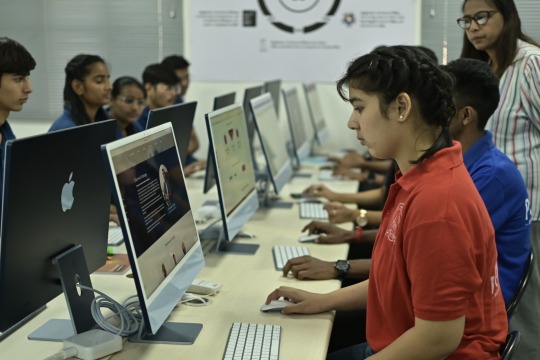
Understanding Plagiarism
Plagiarism is the act of using someone else's work, ideas, or intellectual property without proper attribution. It can take many forms, including copying text, paraphrasing without credit, and submitting someone else's work as one's own. In an academic setting, plagiarism can lead to severe consequences, including loss of credibility, academic penalties, and damage to one’s reputation.
The Role of AI in Plagiarism Detection
Let us now shift our discussion to the role of artificial intelligence in plagiarism detection. Here are some essential ways AI facilitates the detection of plagiarism:
1. Advanced Algorithms: AI-powered plagiarism detection tools utilize advanced algorithms to analyze text for similarities with existing sources. At Poddar International College, the top MCA college, we encourage students to use these tools to ensure their work is original and properly cited. These tools can compare submitted work against vast databases of academic papers, articles, and online content, identifying potential instances of plagiarism.
2. Natural Language Processing (NLP): AI employs Natural Language Processing to understand the context and semantics of the text. This capability allows AI tools to detect not only direct copying but also paraphrased content that may not be easily identifiable through traditional methods. By leveraging NLP, students can receive more accurate assessments of their work, helping them improve their writing skills.
3. Real-Time Feedback: Many AI plagiarism detection tools offer real-time feedback, allowing students to check their work before submission. You will learn with a BCA course in Jaipur that this feature enables them to make necessary adjustments and ensure that their writing adheres to academic standards. At Poddar International College, we integrate these tools into our writing programs, promoting a culture of originality and self-improvement.
4. Educational Resources: AI can also provide educational resources to help students understand plagiarism and how to avoid it. By offering tutorials, writing guides, and citation tools, AI empowers students to develop their writing skills and learn the importance of proper attribution. Our college emphasizes the use of these resources to foster a deeper understanding of academic integrity.
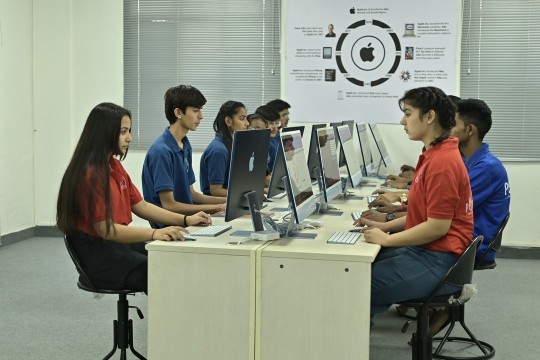
Promoting a Culture of Originality
At Poddar International College, the best BCA college in Jaipur, we believe that the use of AI in plagiarism detection is just one part of a broader strategy to promote originality. We encourage students to engage in ethical research practices, develop their unique voices, and appreciate the value of original thought.
By incorporating AI tools into our academic framework, we aim to create an environment where students feel supported in their writing endeavors. This approach not only helps in reducing instances of plagiarism but also enhances the overall quality of academic work produced by our students.
0 notes
Text
Using Different Tools and Technologies in the Field of Information Technology
In today’s fast-paced digital world, the field of Information Technology (IT) is constantly evolving, driven by innovative tools and technologies. At Poddar International College, one of the top BCA colleges in Jaipur, we recognize the importance of equipping our students with the knowledge and skills to leverage these advancements effectively. This article explores various tools and technologies in IT and how they can be utilized to enhance learning and professional development.

1. Programming Languages
Programming languages are the backbone of IT, enabling developers to create software applications, websites, and systems. Languages such as Python, Java, and JavaScript are widely used for various applications, from web development to data analysis. At Poddar International College, we offer comprehensive courses in these languages, allowing students to gain hands-on experience and build a strong foundation in programming.
2. Cloud Computing
Cloud computing has revolutionized the way businesses operate by providing scalable resources and services over the internet. Platforms like Amazon Web Services (AWS), Microsoft Azure, and Google Cloud allow organizations to store data, run applications, and manage resources without the need for physical infrastructure. Our top-ranked MCA college in Jaipur integrates cloud computing into the curriculum, teaching students how to utilize these platforms for project management, data storage, and application deployment.

3. Data Analytics Tools
In the age of big data, data analytics tools are essential for extracting insights from vast amounts of information. Tools like Tableau, Power BI, and Google Analytics enable organizations to visualize data, track performance, and make informed decisions. At Poddar International College, we emphasize the importance of data literacy and provide students with training in these tools, preparing them for careers in data analysis and business intelligence.
4. Cybersecurity Technologies
As cyber threats become more sophisticated, the need for robust cybersecurity measures is paramount. Students of the BCA course in Jaipur will learn that technologies such as firewalls, intrusion detection systems, and encryption tools are critical for protecting sensitive information. Our college offers specialized courses in cybersecurity, equipping students with the skills to implement security protocols and safeguard digital assets.

5. Artificial Intelligence and Machine Learning
At Poddar International College, we incorporate AI and ML into our BCA and MCA courses in Jaipur, encouraging students to explore these technologies and their applications in real-world scenarios. Artificial Intelligence (AI) and Machine Learning (ML) are transforming various industries by automating processes and enabling predictive analytics. Tools like TensorFlow, Keras, and Scikit-learn allow developers to build intelligent applications that can learn from data.
6. Collaboration and Project Management Tools
Effective collaboration is essential in IT projects, and tools like Slack, Trello, and Asana facilitate communication and project management among teams. These platforms help streamline workflows, assign tasks, and track progress, ensuring that projects are completed efficiently. Our college promotes the use of these tools in group projects, preparing students for collaborative work environments.
Conclusion
The field of Information Technology is vast and dynamic, with numerous tools and technologies shaping its future. At Poddar International College, the best IT college in Jaipur, we are committed to providing our students with the knowledge and skills needed to navigate this ever-changing landscape. By integrating these tools into our curriculum, we empower students to become proficient IT professionals ready to tackle the challenges of tomorrow.
0 notes
Text
Mobile App Development as a Catalyst for Digital Transformation
In an era where smartphones have become an integral part of daily life, mobile app development has emerged as a crucial component of the digital landscape. At Poddar International College, a prestigious IT college in Jaipur, we recognize the importance of equipping our students with the skills and knowledge necessary to thrive in this dynamic field. This article explores the significance of mobile app development and its impact on businesses and consumers alike.

The Rise of Mobile Applications
The proliferation of mobile devices has led to a surge in mobile applications across various sectors, including education, healthcare, finance, and entertainment. According to recent statistics, mobile apps account for over 50% of all web traffic, highlighting their importance in reaching and engaging users. As more people rely on their smartphones for everyday tasks, businesses must adapt by developing mobile applications that cater to their customers' needs.
Enhancing User Experience
At Poddar International College, considered the best BCA college in Jaipur, we emphasize the importance of user-centered design in our mobile app development courses. Students are taught how to build intuitive and user-friendly applications. This is because one of the primary reasons for the significance of mobile app development is its ability to enhance user experience. Mobile apps provide a more personalized and interactive experience compared to traditional websites. Features such as push notifications, location-based services, and offline access allow businesses to engage users effectively.
Driving Business Growth
Mobile applications are not just a trend; they are a powerful tool for driving business growth. By offering a mobile app, businesses can increase their visibility, improve customer engagement, and boost sales. Apps enable companies to reach a broader audience and provide a platform for marketing their products and services. Our college, with its MCA course in Jaipur, prepares students to understand the business implications of mobile app development, equipping them with the skills to create applications that align with organizational goals.
Facilitating Communication and Collaboration
Mobile apps play a vital role in facilitating communication and collaboration within organizations. Tools like Slack, Microsoft Teams, and Trello have transformed how teams interact and manage projects. With our BCA course in Jaipur, students learn how these applications enable real-time communication, file sharing, and task management, enhancing productivity and efficiency. At Poddar International College, we teach students how to develop collaborative applications that meet the needs of modern workplaces.

The Future of Mobile App Development
As technology continues to evolve, the future of mobile app development looks promising. Emerging trends such as Artificial Intelligence (AI), Augmented Reality (AR), and the Internet of Things (IoT) are shaping the next generation of mobile applications. These technologies offer new opportunities for innovation and creativity in app development. Our college encourages students to stay updated on these trends, fostering a culture of continuous learning and adaptation.
Conclusion
In today's digital landscape, mobile app development is more significant than ever. It enhances user experience, drives business growth, and facilitates communication and collaboration. At Poddar International College, a renowned MCA college in Jaipur, students receive the necessary knowledge and skills needed to excel in this field. By integrating practical training and industry-relevant projects into our curriculum, we prepare our students to become leaders in mobile app development.
FAQs
1. Which software is used for mobile app development?
Some of the software used for mobile app development include React Native, Apache Cordova, NativeScript, Ionic, and more. You can learn iOS mobile app fundamentals with a BCA or MCA course in Jaipur with Apple Certification at Poddar International College.
2. How do you become a mobile app developer?
Here are steps to become a successful mobile app developer:
Pursue a BCA course in Jaipur at a good college like Poddar International College.
Participate in bootcamps, workshops, and hackathons.
Build projects and prepare an impressive portfolio.
Gain practical experience through internships.
Search and apply to mobile app developer job listings and get your dream job.
3. What is a mobile app developer’s salary?
A fresher mobile app developer’s salary ranges from 3 to 7 LPA, whereas an experienced developer can expect packages above 15 LPA. On an average, a mobile app developer earns somewhere around 5 LPA to 10 LPA.
0 notes
Text
IT Certifications: A Tool for Career Advancement
In the rapidly evolving field of Information Technology (IT), staying ahead of the curve is essential for career advancement. One of the most effective ways to enhance your skills and improve your employability is through IT certifications. At Poddar International College, the top-ranked BCA college in Jaipur, we understand the significance of these certifications in shaping the careers of our students. This article explores the importance of IT certifications and how they can propel your career forward.

Demonstrating Expertise and Knowledge
IT certifications serve as a testament to your expertise and knowledge in specific areas of technology. Whether it’s networking, cybersecurity, cloud computing, or software development, certifications validate your skills and show potential employers that you are committed to your professional growth. At Poddar International College, we encourage our students to pursue relevant certifications that align with their career goals, enhancing their resumes and making them more attractive to employers.
Keeping Up with Industry Trends
The IT landscape is constantly changing, with new technologies and methodologies emerging regularly. Obtaining certifications enables professionals to stay current with the latest industry trends and best practices. For instance, certifications like CompTIA A+, Cisco CCNA, and AWS Certified Solutions Architect ensure that you are well-versed in current technologies. Our top IT college in Jaipur integrates these certification programs into our curriculum, providing students with the opportunity to learn and grow in a structured environment.
Enhancing Job Opportunities
In a competitive job market, having IT certifications can significantly enhance your job prospects. Many employers prioritize candidates with certifications when making hiring decisions. Certifications not only demonstrate your technical skills but also indicate your dedication to the field. At Poddar International College, we prepare our students for the job market by emphasizing the importance of certifications, helping them stand out among their peers.
Increasing Earning Potential
Research shows that IT professionals with certifications tend to earn higher salaries compared to their non-certified counterparts. Certifications can lead to promotions and salary increases, making them a worthwhile investment in your career. By obtaining certifications, you position yourself for higher-paying roles and greater responsibilities within your organization. Our BCA college in Jaipur provides guidance on which certifications can lead to the best career outcomes, ensuring that students make informed decisions.

Building a Professional Network
Pursuing IT certifications often involves joining professional organizations and communities. At Poddar International College, the best MCA college in Jaipur, we encourage students to participate in networking events and workshops, fostering relationships that can benefit their careers. These networks can provide valuable resources, mentorship opportunities, and connections that can aid in your career advancement. Engaging with fellow professionals and industry experts can open doors to new job opportunities and collaborations.
Conclusion
In today’s competitive IT landscape, obtaining certifications is crucial for career advancement. They demonstrate expertise, keep you updated on industry trends, enhance job opportunities, increase earning potential, and help build a professional network. At Poddar International College, ranked best among the top MCA colleges in Jaipur, we are committed to equipping our students with the knowledge and resources needed to succeed in their careers. By integrating certification programs into our curriculum, we prepare our students to excel in the ever-evolving world of Information Technology.
FAQs
1. Which IT course is best for beginners?
A BCA course in Jaipur is best for beginners. You can pursue an undergraduate course in computer applications from Poddar International College. Students can enroll in a BCA program with Apple certification also from here. With this you get live projects, joint certifications, and internships and placements within the Apple ecosystem.
2. Which IT course gets the highest salary?
An IT course that gets the highest salary is business intelligence (BI), DevOps, cybersecurity and ethical hacking, software development, and blockchain technology. An MCA course in Jaipur with Apple certification from Poddar International College, can help you further enhance your chances of getting a high-paying job opportunity.
3. Which IT job is in demand?
The IT jobs in demand in 2025 are software developer, cyber security specialist, blockchain developer, UI/UX designer, big data engineer, and IoT solutions architect.
0 notes
Text
Fashion Entrepreneurship: Navigating the Business Side of Fashion

Fashion entrepreneurship involves not only a passion for design but also a strong understanding of the business aspects of the industry. This article explores the essentials of starting and managing a fashion business, including market analysis, brand development, and financial planning. Additionally, it highlights some of the top M.VOC fashion colleges in Rajasthan, known for their comprehensive curriculum and nurturing environment for aspiring fashion entrepreneurs.
Body:
Market Analysis for Fashion Business: Successful fashion entrepreneurs begin by conducting thorough market analysis to identify target customers, market trends, and potential competitors. This includes understanding consumer preferences, studying industry reports, and analyzing market demand. Top M.VOC fashion colleges in Rajasthan, such as the National Institute of Fashion Technology (NIFT), the Jaipur Institute of Fashion Design (JIFD), Poddar International College, and a few others provide students with the skills to conduct comprehensive market research and apply the findings to inform their business strategies.
Brand Development and Differentiation: Creating a strong and unique brand identity is crucial for fashion businesses. This involves defining the brand's vision, values, and aesthetics, and developing a brand strategy to effectively communicate with the target audience. Top-rated fashion colleges in Rajasthan, including NIFT, JIFD, Poddar International College, and a few others emphasize brand development and differentiation in their M.VOC fashion programs. They teach students about brand positioning, storytelling, and creating a cohesive brand image across various marketing channels.
Financial Planning and Management: Financial planning is a vital aspect of fashion entrepreneurship. Students pursuing an M.VOC in fashion from colleges like NIFT, INIFD, Poddar International College, and a few others learn about financial management, budgeting, and forecasting. They understand the importance of cost analysis, pricing strategies, and profit margins. Additionally, students gain insights into funding options, such as loans, grants, or crowdfunding, and learn to create realistic financial projections to support their business growth.
Successful Fashion Entrepreneurship Case Studies: Exploring real-life case studies of successful fashion entrepreneurs provides valuable insights and inspiration. M.VOC fashion colleges in Rajasthan, including Pearl Academy, JIFD, PIC and a few others often incorporate case studies into their curriculum. Students analyze the journeys of renowned fashion entrepreneurs, such as Anita Dongre, Sabyasachi Mukherjee, and Manish Malhotra, to understand their business strategies, marketing tactics, and brand-building techniques. These case studies highlight the importance of innovation, adaptability, and perseverance in the highly competitive fashion industry.
Fashion entrepreneurship requires a solid understanding of business fundamentals. By focusing on market analysis, brand development, financial planning, and learning from successful case studies, aspiring fashion entrepreneurs can gain the essential knowledge and skills to navigate the business side of the industry. Top M.VOC fashion colleges in Rajasthan, such as NIFT, Poddar International College, and JIFD a few others, provide comprehensive education and mentorship to nurture future fashion entrepreneurs.
0 notes
Text
Enhancing Interior Spaces: The Power of Color and Visual Stimuli

In the realm of interior design, the use of color and visual stimuli holds immense potential to transform spaces and create impactful environments. This article explores the significance of color psychology and visual elements in interior design, highlighting their role in enhancing mood, creating focal points, and fostering a sense of harmony within the built environment. It also mentions some of the top interior design colleges in Rajasthan, known for nurturing creative minds and fostering design excellence.
Body:
Understanding Color Psychology: Color has the ability to evoke emotions, influence behavior, and shape perceptions. Interior designers utilize color psychology to create specific atmospheres within spaces. For example, warm colors like red and orange can evoke energy and stimulate conversation, while cool colors like blue and green promote relaxation and concentration. Top interior design colleges in Rajasthan, such as Poddar International College, Arch Academy, and Pearl Academy, emphasize the understanding and application of color psychology in their curriculum.
Creating Visual Impact: Visual stimuli play a vital role in capturing attention and creating memorable experiences within interior spaces. Through thoughtful selection and placement of visual elements, designers can establish focal points, direct flow, and enhance the overall aesthetics. Interior design programs at Poddar International College, INIFD, Arch Academy, Pearl Academy, and a few others, in Rajasthan nurture students' ability to incorporate visual stimuli effectively. They teach techniques to employ artwork, graphics, patterns, and textures to add depth, intrigue, and visual appeal to interior environments.
Balancing Harmony and Contrast: Achieving a harmonious visual composition is crucial in interior design. Color schemes, patterns, and textures must be balanced to create a cohesive and pleasing environment. Top-rated interior design colleges in Rajasthan, including Poddar International College, Arch Academy Pearl Academy, and some others, focus on teaching students the principles of harmony and contrast. They impart knowledge about color schemes, color combinations, and the use of complementary or analogous colors to strike the right balance and create visually pleasing spaces.
Incorporating Cultural and Brand Identity: Interior design in Rajasthan often celebrates its rich cultural heritage. Designers are encouraged to integrate cultural elements and symbols into the interior spaces they create. Top interior design colleges in Jaipur, such as Poddar International College Pearl Academy, Arch Academy, and some others provide students with insights into local design traditions and help them understand how to incorporate regional aesthetics into contemporary designs. Additionally, these colleges emphasize the importance of considering brand identity while designing commercial spaces, ensuring that the visual stimuli align with the brand's values and appeal to its target audience.
Color and visual stimuli are powerful tools that interior designers wield to create visually engaging and impactful spaces. The best interior design colleges in Rajasthan, including Poddar International College, Arch Academy, Pearl Academy, and others, equip students with the knowledge and skills to utilize color psychology, incorporate visual elements, and achieve harmony within interior environments. By understanding the potential of color and visual stimuli, designers can elevate spaces to new heights of aesthetic appeal and experiential delight.
0 notes
Text
The Era of Explainable AI: Understanding and Trusting Intelligent Systems
In the rapidly advancing field of artificial intelligence (AI), the quest for creating intelligent systems capable of making decisions is accompanied by a growing demand for transparency and understanding. Enter the era of Explainable AI (XAI), a paradigm shift that prioritizes not just the accuracy of AI models but also the comprehensibility of their decision-making processes. This article from Poddar International College, the best BCA college in Jaipur, explores the significance of Explainable AI, why it matters, and how it is shaping the landscape of intelligent systems.

The Need for Explainability
As AI systems become more integrated into our daily lives, influencing decisions in finance, healthcare, criminal justice, and beyond, the question of trust and accountability becomes paramount. Traditional black-box AI models, while capable of delivering accurate results, often lack transparency, leaving users and stakeholders in the dark about how decisions are made. This opacity raises concerns about bias, ethics, and the potential for unintended consequences.
Understanding AI's Decision-Making
Explainable AI, often discussed in our BCA course in Jaipur, seeks to demystify the decision-making process of complex algorithms and neural networks. In essence, it aims to bridge the gap between the machine's reasoning and human comprehension. When an AI system offers clear explanations for its outputs, users understand the reasoning behind decisions, building trust and enhancing human-AI collaboration.
Applications in Healthcare
In the healthcare sector, where AI is increasingly employed for diagnostics, treatment recommendations, and patient care, explainability is crucial. Imagine a scenario where an AI model recommends a specific treatment plan for a patient. Explainable AI can provide detailed insights into the factors that influenced the recommendation, such as relevant medical literature, patient history, and diagnostic data. This not only helps medical professionals make informed decisions but also ensures accountability in critical healthcare interventions.
Addressing Bias and Fairness
One of the primary challenges in AI, as discussed in our MCA course in Jaipur, is the presence of bias in training data, leading to biased predictions and decisions. Explainable AI plays a pivotal role in identifying and addressing these biases by providing transparency into the decision-making process. Researchers and developers can scrutinize models to understand the source of bias and take corrective measures to ensure fairness and equity in AI applications.

Enhancing Financial Decision-Making
In the financial industry, AI is widely employed for risk assessment, fraud detection, and investment strategies. Explainable AI is instrumental in elucidating the factors that contribute to financial decisions, helping stakeholders comprehend the rationale behind credit approvals, investment recommendations, and risk assessments. This transparency not only fosters trust but also allows for better-informed financial decision-making.
Regulatory Compliance and Accountability
The advent of Explainable AI is closely aligned with regulatory efforts to ensure ethical and responsible AI deployment. Regulations such as the General Data Protection Regulation (GDPR) in Europe emphasize the right of individuals to understand the logic behind automated decisions. Explainable AI provides a means to comply with such regulations. According to IT colleges in Jaipur and India, this offers transparency and accountability in AI systems, thus addressing legal and ethical considerations.
Challenges and Progress
While the importance of Explainable AI is clear, implementing it is not without challenges. Striking the right balance between model accuracy and interpretability is a delicate task. Researchers are actively developing techniques that provide both high-performance models and understandable explanations. The challenge lies in making AI systems transparent without compromising their effectiveness.
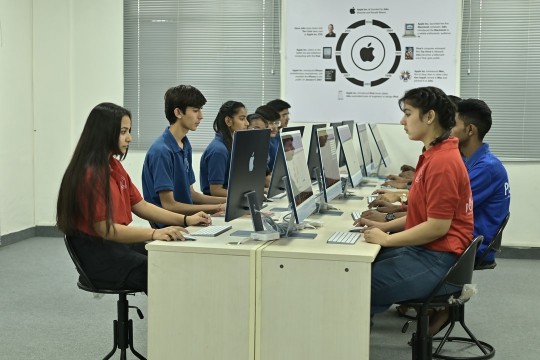
The Future of Explainable AI
As the field of AI continues to evolve, the demand for Explainable AI is likely to grow. Researchers are exploring innovative approaches, including model-agnostic methods, interpretable machine learning models, and interactive visualization tools. Our Apple Lab in Jaipur motivates the young tech talent to take an innovative approach towards the latest technologies. The future holds the promise of AI systems that not only deliver accurate results but also empower users to trust, understand, and collaborate with intelligent machines seamlessly.
ConclusionIn the era of Explainable AI, the focus on transparency and understanding marks a significant step forward in the responsible development and deployment of intelligent systems. As AI becomes an integral part of various industries, the need for explainability is not just a technical requirement but a societal imperative. By unraveling the intricacies of AI decision-making, we at Poddar International College, one of the top 5 MCA colleges in Jaipur, pave the way for the future transformation. A future where humans and machines can collaborate with trust, accountability, and a shared understanding of the intelligent systems that shape our world.
0 notes
Text
Blockchain Beyond Cryptocurrency: Exploring Its Impact on Industries
Originally designed as the underlying technology for cryptocurrencies, blockchain has rapidly evolved into a versatile and transformative force with far-reaching implications for various industries. While cryptocurrency remains a prominent application, the impact of blockchain technology extends well beyond digital currencies. This article from the Poddar Group of Institutions, a top MCA college in Jaipur, examines the various ways blockchain is transforming industries by enhancing transparency, security, and efficiency.

The Foundation of Trust
At its core, blockchain is a decentralized and distributed ledger that records transactions across a network of computers. The key innovation lies in its ability to create a secure and transparent chain of blocks, each containing a list of transactions. Once a block is added to the chain, it becomes nearly impossible to alter, ensuring a tamper-resistant record of data. This inherent trustworthiness is a game-changer for industries seeking to enhance reliability and security in their operations.
Supply Chain Management Revolution
A significant impact of blockchain is seen in supply chain management. An MCA course in Jaipur and India discusses how technology allows for the creation of an immutable record of every transaction or event within the supply chain, from manufacturing to distribution. This transparency not only reduces the risk of fraud but also enables real-time tracking of goods, enhancing efficiency and reducing costs. Retailers and consumers can trace the origin and journey of products, fostering accountability and ethical sourcing practices.
Smart Contracts: Automating Legal Processes
Blockchain introduces the concept of smart contracts, self-executing contracts with the terms directly written into code. These contracts automatically execute when predefined conditions are met, eliminating the need for intermediaries and reducing the risk of errors. Industries such as real estate, insurance, and legal services are leveraging smart contracts to streamline processes, reduce paperwork, and enhance the efficiency of transactions.
Financial Services and Decentralized Finance (DeFi)
While cryptocurrency remains an integral part of the financial sector, blockchain's impact goes beyond digital currencies. A BCA course in Jaipur or other regions will discuss decentralized finance (DeFi). The concept is gaining momentum, allowing for the development of financial services without traditional intermediaries. Smart contracts enable peer-to-peer lending, decentralized exchanges, and automated asset management, providing users with greater control over their financial transactions and assets.
Healthcare Data Management
In the healthcare industry, where the security and integrity of patient data are paramount, blockchain offers a solution to streamline data management. Blockchain can create a secure and interoperable system for sharing medical records, ensuring data accuracy, and enhancing patient privacy. Patients have greater control over their health data, granting access only to authorized parties while ensuring the integrity of the information.
Intellectual Property and Copyright Protection
Blockchain's immutability and transparency are valuable assets for the protection of intellectual property and copyrights. Content creators, artists, and musicians can use blockchain to timestamp and authenticate their work, creating an indisputable record of ownership. This not only reduces instances of piracy but also ensures that creators receive fair compensation for their intellectual contributions.
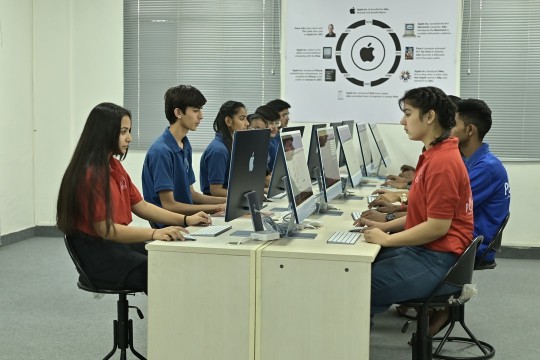
Energy Trading and Grid Management
In the energy sector, according to the top MCA colleges across the globe, blockchain is transforming the way energy is traded and managed. Through blockchain-based platforms, producers and consumers can engage in peer-to-peer energy trading, bypassing traditional energy providers. Smart grids powered by blockchain enable real-time monitoring and control of energy distribution, promoting sustainability and efficiency in the energy ecosystem.
Challenges and Future Outlook
Despite its transformative potential, blockchain faces challenges such as scalability, interoperability, and regulatory concerns. As the technology continues to mature, ongoing research and development aim to address these issues. The future outlook for blockchain remains promising, with ongoing advancements likely to expand its applications and impact across industries.
ConclusionBlockchain's journey from its origins in cryptocurrency to its current status as a transformative force across industries is a testament to its potential. As industries embrace the technology, they unlock new possibilities for transparency, security, and efficiency. At Poddar International College, ranked as the top IT college in Jaipur, students learn how blockchain is reshaping the way businesses operate and interact. As research and development continue, the full extent of blockchain's impact on industries is yet to be realized, promising a future where decentralized, transparent, and secure systems become the norm across various sectors.
0 notes
Text
Career Opportunities in Botany: A Comprehensive Guide
Botany is a popular choice in the science stream due to good career opportunities. The majority of the science colleges in Jaipur and India believe it to be an exciting and remunerative career path. The world will always require botanists, and the study of plant science will always be important because plants are crucial components of our planet’s biodiversity. Botany is a window into the remarkable world of plants, offering a deeper understanding of the vital role they play in sustaining life on Earth. From the smallest cellular structures to the vast ecosystems they contribute to, botany encompasses a broad spectrum of knowledge.
As we continue to unlock the mysteries of plant life, botany remains an essential discipline that holds the key to addressing environmental challenges and ensuring a sustainable future for our planet. A B.Sc course in Jaipur or India, in botany opens up a wide range of career opportunities for individuals passionate about plants, ecosystems, and the environment. Whether you are interested in research, conservation, education, or industry, the field of botany offers diverse paths to explore. Here are some prominent career opportunities in botany:
1. Research Scientist
Research plant biology, genetics, physiology, ecology, or taxonomy.
Work in universities, research institutions, or private companies, developing new insights into plant life.

2. Ecologist
Study the relationships between plants and their environments.
Work on conservation projects, ecosystem restoration, or environmental impact assessments.
3. Botanical Illustrator
Combine artistic skills with botanical knowledge to create accurate and visually appealing illustrations of plants for scientific publications, educational materials, and botanical gardens.
4. Horticulturist
Cultivate and manage plants for various purposes, such as ornamental gardens, agriculture, or landscaping.
Work in botanical gardens, nurseries, or agricultural enterprises.
5. Conservation Biologist
Focus on the preservation of plant species and ecosystems.
Work with environmental organizations, government agencies, or non-profits to develop and implement conservation strategies.
6. Plant Breeder
Develop new plant varieties with desired characteristics, such as improved yield, disease resistance, or unique traits.
Employment opportunities exist in agricultural companies, research institutions, and seed companies.

7. Environmental Consultant
Assess and mitigate the environmental impact of human activities on plant life.
Work with consulting firms or government agencies to ensure compliance with environmental regulations.
8. Educator
Teach botany at the high school or college level.
Develop educational programs for botanical gardens, museums, or environmental education centers.
9. Plant Pathologist
Investigate and manage plant diseases.
Work in agriculture, forestry, or research institutions to develop strategies for disease prevention and control.
10. Park Ranger or Naturalist
Educate the public about plants and ecosystems.
Work in national parks, nature reserves, or environmental education centers.
11. Pharmaceutical Botanist
Explore the medicinal properties of plants and contribute to the development of pharmaceutical drugs.
Employed by pharmaceutical companies or research institutions.
12. Urban Planner or Landscape Architect
Integrate plants and green spaces into urban planning for environmental sustainability and aesthetic purposes.
Work with city planning departments or private design firms.
13. Plant Geneticist
Study the genetic makeup of plants and contribute to the understanding of plant genetics and biotechnology.
Employment opportunities in research institutions or biotechnology companies.
14. Seed Analyst
Evaluate the quality and characteristics of seeds for agricultural and horticultural purposes.
Employed by seed companies, agricultural agencies, or quality control labs.
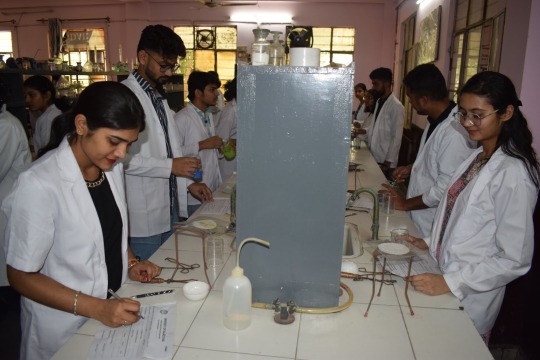
15. Biotechnology Researcher
Apply biotechnological techniques to improve plant traits, such as resistance to pests or environmental stress.
Work in research and development for biotech companies or agricultural enterprises.
The field of botany continues to evolve with advancements in technology and our understanding of plant life. Botanists can find fulfilling careers in a variety of sectors, contributing to scientific knowledge, environmental conservation, and sustainable development. Additionally, you can pursue an M.Sc course in Jaipur from Poddar International College to upgrade your career and apply for high-paying job opportunities.
0 notes
Text
Uncovering Nature's Mysteries: Fascinating Domain of Soil Science for Young Explorers!
Ever thought of the enchanted realm that lies beneath our feet? It's time to take an exciting trip into the amazing field of soil science. The earth we walk on has a secret life of its own. We'll delve deep into this trip to solve the mysteries of soil and find why it's such an intriguing subject for inquisitive minds like yours. At Poddar International College, the best B.Sc college in Jaipur, our faculty members often organize engaging discussions on a diverse range of topics. This article summarizes one such insightful discussion on soil science.

Unraveling the Soil Mysteries
1. Under Our Feet
Ever given any thought to what's underneath the flowers and grass? Beyond just dirt, soil is a living, breathing ecosystem with layers just waiting to be discovered. There are many soil layers as we go deeper into the earth and come across the minuscule, active organisms that live there.
2. The Magic Components of Soil
Consider soil to be the natural plant-growing medium. It contains a unique and powerful combination of minerals, water, air, and specific nutrients that plants require to grow large and robust. We'll learn the techniques behind this recipe and how each component adds to the rich life in the soil.
3. Ant-sized marvels
Get ready to reduce the size of a little bug! We'll meet amazing bacteria, the soil's superheroes, in the microscopic world of soil. These microscopic organisms are vital to the growth of plants, the decomposition of organic materials, and the fertility of the soil. Students at our top B.Sc college in Jaipur, Poddar International College, research these bacteria in our well-equipped labs.
4. Earth's Defenders, Soil Superheroes
Did you know that the Earth's soil functions similarly to a superhero cape? It serves as a layer of defense, shielding our planet from erosion and promoting the growth of plants. We'll learn how dirt transforms into a superhero that protects the environment and all living creatures.
5. Farming is Fun
Just picture how much fun it is to raise your own fruits and vegetables! To accomplish that, we must understand how to care for the soil, which serves as the groundwork for our gardening endeavors. We'll check how healthy soil is essential to giving plants a nice place to live and to realizing our gardening goals.
6. Nature's Recyclers
Ever wonder where old plants and leaves go when they die? It is possible for soil to recycle itself! At our science college in Jaipur, students discover the workings of nature's recyclers in the soil, learning how they decompose organic materials and support the life cycle.
Why is Soil Science Super Cool?
1. Become a Soil Scientist Explorer
You can become a true explorer of the hidden gems of Earth by learning more about soil science. Imagine yourself as a superhero scientist, solving the soil's secrets and contributing significantly to our knowledge of and protection of the environment.
2. Grow Your Garden journey
You can begin your garden journey with an understanding of soil science. Knowing the tricks of the soil, you can do anything from planting flowers to watching veggies develop to perhaps even forming a tiny nature club with friends.
3. Defend Our Planet
As an explorer in soil science, you join a group committed to preserving our planet. By taking good care of the soil, you may help keep the planet green and habitable for future generations.Are you interested in studying soil science further? Check out Poddar International College’s B.Sc and M.Sc courses in Jaipur. We offer degree programs in various subjects, including Botany, Zoology, Physics, Maths, and Chemistry.
0 notes
Text
Leveraging Ancient Wisdom: The Healing Power of Medicinal Plants
The ancient wisdom of medicinal plants continues to be essential in the healthcare system, where modern medicine often relies on synthetic medicines and advanced technologies. These plants were used centuries ago by various cultures to treat different diseases, demonstrating a foundation in medicinal science. Their medicinal properties offer a holistic approach to healing, addressing not only symptoms but also the underlying causes of disease.
At Poddar International College, the top science college in Jaipur, we not only examine the latest developments in science but also explore ancient knowledge systems to provide a comprehensive understanding of different topics in science. This article is a glimpse into our informative and engaging classrooms, where students learn about medicinal plants and their significance in modern science.

Historical Significance
The use of medicinal plants has been a part of traditional Chinese medicine, Indian Ayurveda, and indigenous healing traditions since ancient times. These societies were aware of the therapeutic properties of plants such as aloe vera, ginseng, ginger, and turmeric. This information eventually traveled around the world, impacting how herbal medicine developed in various areas.
Biodiversity and Medicinal Plants
The Earth is home to an astounding variety of plant species, many of which possess medicinal properties. The rich biodiversity ensures a wide range of therapeutic options, catering to diverse health needs. For example, the rainforests of the Amazon are a treasure trove of medicinal plants, with species like cat's claw and dragon's blood offering unique healing benefits.
Common Medicinal Plants
Many common plants have been found to offer therapeutic benefits. Known for its calming qualities, aloe vera is applied topically to soothe burns and skin irritations. Due to its antimicrobial properties and potential cardiovascular benefits, garlic has long been used in traditional medicine. Furthermore, there is ample evidence supporting the sedative qualities of chamomile and the anti-inflammatory effects of turmeric. Our B.Sc course in Jaipur would discuss other plants with medicinal properties in detail.

Validation by Modern Science
Although traditional knowledge established the groundwork, contemporary science has been progressively confirming the therapeutic qualities of plants. As a result of the active compounds that researchers have extracted from medicinal plants, pharmaceutical drugs have been developed. For example, the widely used drug aspirin was developed as a result of the pain-relieving qualities of willow bark.
Holistic Healing Approach
Medicinal plants offer a holistic approach to healing, addressing not only the physical symptoms but also promoting overall well-being. Top M.Sc colleges consider this as aligning with the growing interest in complementary and alternative medicine, where patients seek solutions that encompass mind, body, and spirit. Herbal remedies often focus on supporting the body's natural healing processes, promoting balance and harmony.
Difficulties and Conservation
Medicinal plants offer numerous benefits. However, they face several challenges, including overharvesting, habitat destruction, and climate change. The excessive use of certain plant species can lead to their depletion, jeopardizing future generations' access to these valuable resources. To ensure biodiversity and promote sustainable harvesting practices, it is crucial to implement conservation efforts.
Cultural Diversity
Our M.Sc. course in Jaipur explores the long history of medicinal plant use, which is deeply rooted in the customs and practices of various cultures. Indigenous communities worldwide continue to use plant-based remedies that have been passed down through generations. A positive relationship between contemporary medicine and conventional healing methods depends on acknowledging and respecting this cultural diversity.
ConclusionWith their many therapeutic uses, medicinal plants are still a source of inspiration and solace for people. At Poddar International College, a top-ranked B.Sc college in Jaipur, we believe that the knowledge of traditional medicine encourages us to appreciate the abundance of nature while we negotiate the complexity of contemporary healthcare. A holistic approach to health that recognizes the interdependence of all living things is ensured by striking a balance between modern scientific discoveries and traditional knowledge of medicinal plants. It appears that nature is the key to a happier and healthier future.
0 notes